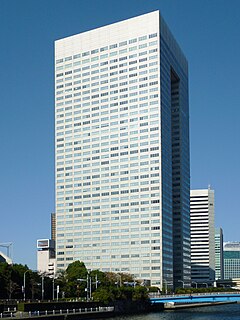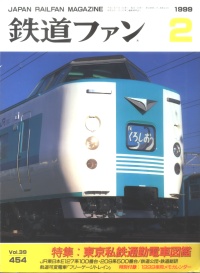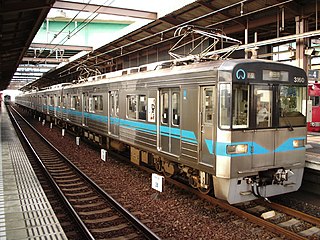
The Tsurumai Line is a subway line which forms part of the Nagoya Municipal Subway system in Nagoya, Japan. It runs from Kami Otai in Nishi-ku, Nagoya to Akaike in Nisshin. The Tsurumai Line's color on maps is light blue. Its stations carry the letter T followed by a number. Officially, the line is called Nagoya City Rapid Railway Line 3. All the stations accept manaca, a rechargeable contactless smart card.

The Isumi Line is a railway line in Chiba Prefecture, Japan, operated by the third-sector railway operating company Isumi Railway Company. It extends through the central eastern section of the Bōsō Peninsula, linking Ōhara Station in the city of Isumi, where it connects with the Sotobō Line, to Kazusa-Nakano Station in the town of Ōtaki, where it connects with the Kominato Line.
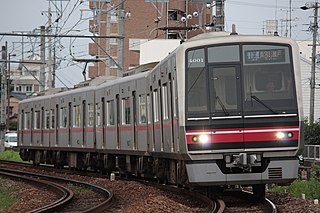
The Meitetsu 4000 series (名鉄4000系) is a commuter electric multiple unit (EMU) train type operated by Nagoya Railroad (Meitetsu) in Japan since 2008.

The Class E31 is a class of DC Bo-Bo wheel arrangement electric locomotives formerly operated by the private railway operator Seibu Railway in Japan until March 2010 and subsequently by the Ōigawa Railway.

The Meitetsu 1700/2300 series (名鉄1700・2300系) is an electric multiple unit (EMU) train type operated by the private railway operator Nagoya Railroad (Meitetsu) in Japan since December 2008.

The Class EF66 (EF66形) is a six-axle, three-bogied (Bo′Bo′Bo′) DC electric locomotive designed for fast freight used by Japanese National Railways (JNR) and later operated by its descendents JR West and JR Freight. As of 1 April 2016, 39 locomotives remained in service, all operated by JR Freight.

The Class EF210 (EF210形) is a Bo-Bo-Bo wheel arrangement DC electric locomotive type operated by Japan Freight Railway Company on freight services in Japan.

The Class EF65 (EF65形) is a 6-axle DC electric locomotive type operated on passenger and freight services in Japan since 1965. A total of 308 locomotives were built between 1965 and 1979, with 52 still in service as of 1 April 2016.

The Class EF81 is a six-axle Bo-Bo-Bo wheel arrangement multi-voltage AC/DC electric locomotive type operated on passenger and freight services in Japan since 1968. As of 1 April 2016, 44 locomotives remained in service, operated by JR Freight, JR East, and JR West.

The Class EF55 (EF55形) is a 2Co+Co1 wheel arrangement electric locomotive type consisting of three locomotives built in 1936 by Hitachi, Kawasaki, and Tōyō Electric in Japan. They were nicknamed "Moomin".
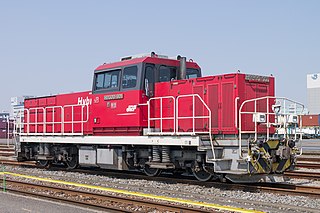
The Class HD300 (HD300形) is a hybrid diesel/battery Bo-Bo wheel arrangement shunting locomotive type operated by Japan Freight Railway Company in Japan. Following the delivery and evaluation of a prototype locomotive in March 2010, the first full-production locomotive entered service in February 2012.

The Nagoya Municipal Subway 6050 series (名古屋市交通局6050形) is a rapid transit electric multiple unit (EMU) train type operated by the Transportation Bureau City of Nagoya on the Nagoya Subway Sakura-dōri Line in Japan since July 2010.
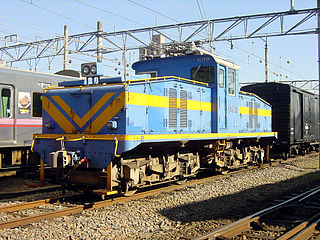
The Meitetsu DeKi 600 was a Bo-Bo wheel arrangement electric locomotive type operated by private railway operator Nagoya Railroad (Meitetsu) in Japan from 1943 until 2015.

The Meitetsu DeKi 400 was a Bo-Bo wheel arrangement electric locomotive type operated by private railway operator Nagoya Railroad (Meitetsu) in Japan.
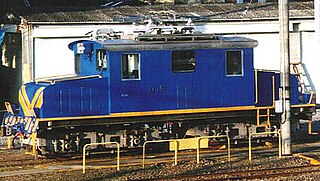
The Meitetsu DeKi 300 is a Bo-Bo wheel arrangement electric locomotive type operated by private railway operator Nagoya Railroad (Meitetsu) in Japan. The locomotives were used primarily on track maintenance trains, but following their withdrawal in 2014, only one locomotive, DeKi 303, remains in use, limited to depot shunting duties at Meitetsu's Maigi Maintenance Depot.
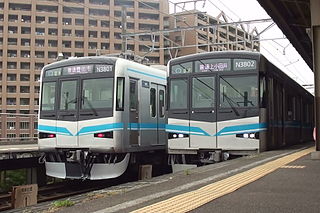
The Nagoya Municipal Subway N3000 series (名古屋市交通局N3000形) is a rapid transit electric multiple unit (EMU) train type operated by the Transportation Bureau City of Nagoya on the Nagoya Subway Tsurumai Line in Japan since March 2012.

The Class EH800 (EH800形) is a Bo′Bo′+Bo′Bo′ wheel arrangement multi-voltage AC two-unit electric locomotive type operated by Japan Freight Railway Company in Japan hauling freight trains on the Kaikyō Line through the Seikan Tunnel separating mainland Honshu with the northern island of Hokkaido. A prototype locomotive was delivered in January 2013 for evaluation and testing, with full-production locomotives delivered from June 2014, entering service from July 2014.

The Chichibu Railway Class DeKi 100 (秩父鉄道デキ100形) is a Bo-Bo wheel arrangement DC electric locomotive type operated by the private railway operator Chichibu Railway in Saitama Prefecture, Japan, primarily on freight services, since 1951.

The ET122 is a diesel multiple unit (DMU) train type operated by the third-sector railway operator Echigo Tokimeki Railway (ETR) on the Nihonkai Hisui Line between Naoetsu and Ichiburi in Niigata Prefecture since operations on the line were transferred from West Japan Railway Company on 14 March 2015. Built by Niigata Transys and based on the JR West KiHa 122 series DMU design, the fleet consists of a total of eight single-car units.

The Class DD15 (DD15形) is a four-axle Bo-Bo wheel arrangement diesel-hydraulic locomotive type operated in Japan as a self-propelled snowplough unit since 1961 by the national railway company Japanese National Railways (JNR), and later by East Japan Railway Company and West Japan Railway Company. A total of 50 locomotives were built between 1961 and 1966, and as of 1 April 2016, 6 locomotives remain in service.


